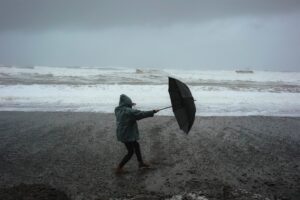Note: this post is derived from the end of Chapter 2.3 of “The HyFlex Book” (full reference below) I am revisiting this story now because our recent global experience with forced mass campus closures in March 2020 has given everyone an experience like this. HyFlex supports instructional continuity in both short and long-term campus closure situations.
What Happens When the University Cannot Host Classes? (A faculty short story…)
[Note: This short story was written in 2018 by a HyFlex faculty shortly after a weather-related campus closure event a few years ago. The same scenario has played out several times in the ensuing years. And now, in 2021 we have all lived through an even longer campus closure, from a few weeks or months to over a year!]
Emergency notification received: campus has been closed due to loss of power from the storm.

What is a faculty to do? If you have a HyFlex class, you can simply require all your students to meet online for that session. This works well if they all have network access, the tools and ability to participate in the online mode, and the time to do so. In our graduate program, it’s never been a problem to occasionally shift to online-only learning when the campus environment is not available.
We had occasion to do this on a recent (2018) night of classes after our university lost most electric power for several hours. An hour before our graduate courses were scheduled to begin for that evening, all classes were canceled. Because I am using the HyFlex design in the courses I teach, all I had to do was send an email to my students telling them to complete their participation requirements online (and asynchronous) for that week. Because the online option was already prepared for those students who were going to choose to participate that way already, I didn’t have to create a single new resource or activity … the online course materials and activities were already there!
I’m sure being forced into the online asynchronous mode was not convenient or simple for some students, but it was better than missing out on up to 10% of the content and interaction of their course. Graduate students, perhaps more than many undergraduates, often want to get as much as possible from their course experiences, since they are often paying dearly, in time and other resources.
There was still some difficulty, since while the campus power was off our locally-hosted LMS was off line, so students couldn’t immediately access course materials during the regularly scheduled class time. With a little schedule accommodation for quizzes and such, all were able to complete the participation requirements later during the week.

It’s nice when things work out well, even when unplanned events drive a change in plans. And in our geography (San Francisco Bay Area), being able to restore academic operations quickly after an unplanned event (such as a storm, transit strike, major earthquake, or global pandemic) that could close our campus for days or weeks is very important.
If you’ve used HyFlex or similar approaches to support instructional continuity, how did that work for you and your students? Tell us your own short story in the comments below.
Reference: Beatty, B. J. (2019). Supporting Hybrid-Flexible Courses and Programs: The Adminstrator Experience with HyFlex Courses and Programs. In B. J. Beatty, Hybrid-Flexible Course Design: Implementing student-directed hybrid classes. EdTech Books. Retrieved from https://edtechbooks.org/hyflex/admin_factors
[…] discussed this need before – see blog posts: Build to Pivot, Instructional Continuity “by Design”, and Preparing for a New Normal – […]